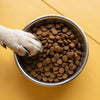Can You Put Dry Dog Food in the Fridge? The Ultimate Guide to Proper Storage for Fresh Kibble
- Houndsy
Table of Contents
- Introduction
- The Importance of Proper Dog Food Storage
- Can You Refrigerate Dry Dog Food?
- How to Store Dry Dog Food Properly
- Understanding Shelf Life: How Long Does Dog Food Last?
- Why Houndsy’s Kibble Dispenser Enhances Feeding Experiences
- Conclusion
Introduction
Imagine this: you walk into your kitchen to find your dog’s food bowl empty, and you’re faced with a large bag of dry kibble that’s been opened for weeks. How can you ensure that your furry friend enjoys every bite without compromising their health or the food’s quality? You might ask yourself, can you put dry dog food in the fridge? As pet owners, we know that the right storage methods can make all the difference in maintaining the freshness and nutritional value of our dogs’ meals.
In this comprehensive guide, we will explore the best practices for storing dry dog food, including the implications of refrigerating kibble, what can go wrong if it's not stored properly, and how to maintain its quality over time. You’ll learn valuable insights about the shelf life of dog food, the effects of temperature and moisture, and practical tips on how to keep your pet's food fresh and safe.
We invite you to reflect on your own pet feeding routines and consider the effectiveness of your current storage methods. By the end of this post, you’ll have a clearer understanding of whether refrigeration is a viable option for your dog’s kibble, and how to optimize your pet’s feeding experience with Houndsy’s innovative feeding solutions, like our Houndsy Kibble Dispenser.
The Importance of Proper Dog Food Storage
Dry dog food is crafted to be shelf-stable, but once opened, its quality can be compromised by various environmental factors. Proper storage is vital for several reasons:
- Maintaining Nutritional Value: Dry kibble is formulated with essential nutrients that can degrade when exposed to light, air, and moisture. Proper storage helps preserve these nutrients, ensuring your dog receives a balanced diet.
- Preventing Spoilage: Exposure to moisture can lead to mold growth, while high temperatures can cause rancidity. Both can pose health risks to your pet.
- Keeping It Tasty: Fresh food is more palatable for dogs. Stale or spoiled kibble can lead to a decline in appetite and overall health.
- Reducing Waste: By storing food correctly, you can extend its shelf life, reducing the frequency of repurchases and waste.
Understanding the best practices for storing dry dog food will allow us to provide our pets with the healthy meals they deserve, while also supporting our commitment to convenience and quality.
Can You Refrigerate Dry Dog Food?
The Case for Refrigeration
Refrigerating dry dog food might seem like a good option to prolong its freshness. However, it’s essential to weigh the pros and cons before making this decision:
-
Pros:
- Refrigeration can slow down the process of fat oxidation, potentially extending the shelf life of opened kibble.
- It may keep the food cool and dry, preventing spoilage from heat and humidity.
-
Cons:
- Moisture can accumulate in the fridge, leading to mold development if the bag is not sealed properly.
- The cold temperature can alter the texture and taste of the kibble, making it less appealing to your dog.
- If the kibble absorbs odors from other foods in the refrigerator, it could affect its palatability.
Expert Opinions
Many pet food manufacturers recommend against refrigerating dry kibble due to the risk of moisture buildup and potential spoilage. It’s typically best to store dry dog food in a cool, dry place away from direct sunlight, like a pantry or a designated food storage area.
If you decide to refrigerate dry dog food, ensure it is kept in an airtight container to combat moisture and odors. This can help mitigate some of the risks associated with refrigeration.
How to Store Dry Dog Food Properly
To keep your dog’s kibble fresh and safe, follow these best practices:
1. Use Airtight Containers
Storing dry dog food in airtight containers is one of the most effective ways to prevent spoilage. Here’s why:
- Protection Against Air and Moisture: Airtight containers help minimize exposure to air, preventing oxidation and moisture retention, which can lead to mold.
- Pest Prevention: Containers can keep pests, such as insects and rodents, away from your dog’s food, ensuring it remains uncontaminated.
- Convenience: Using containers allows for easy dispensing and reduces mess, making feeding more convenient.
2. Keep the Original Packaging
If your dog food comes in a resealable bag, consider keeping it in the bag while also placing it inside an airtight container. This adds an extra layer of protection while retaining important information like expiration dates and lot numbers.
3. Store in a Cool, Dry Place
The ideal storage environment for dry dog food is a cool, dry place with a consistent temperature, ideally below 80°F. Avoid areas where temperatures can fluctuate, such as garages or sheds.
4. Avoid Freezing
While freezing can prolong the shelf life of some foods, it’s not advisable for dry dog food. Freezing and thawing can lead to moisture buildup, which can compromise the kibble’s quality and taste.
5. Monitor Expiration Dates
Always check the expiration or “best by” dates on packaging. Once opened, dry dog food should ideally be consumed within one month, depending on storage conditions. If you notice any changes in smell, texture, or appearance, it’s best to err on the side of caution and discard it.
Understanding Shelf Life: How Long Does Dog Food Last?
Unopened Dry Dog Food
Unopened dry dog food can last anywhere from 12 to 24 months, depending on the brand and storage conditions. Always refer to the packaging for specific shelf life information.
Opened Dry Dog Food
Once opened, dry dog food should be consumed within one month to ensure freshness and quality. The clock starts ticking as soon as the kibble is exposed to air, so it’s essential to store it properly.
Signs of Spoilage
It’s crucial to monitor your dog’s food for any signs of spoilage. Here are a few indicators that your kibble may have gone bad:
- Rancid Smell: If the kibble develops a sour or rancid odor, it’s time to toss it out.
- Moisture or Mold: Any signs of moisture or mold indicate that the food has been compromised.
- Bugs or Pests: If you find insects or pests in the food, it’s best to discard it immediately.
- Changes in Texture: If the kibble appears clumpy or has changed in texture, it could be a sign of spoilage.
Why Houndsy’s Kibble Dispenser Enhances Feeding Experiences
At Houndsy, we believe that feeding should be a seamless and enjoyable experience for both you and your pet. Our flagship product, the Houndsy Kibble Dispenser, is designed with both functionality and style in mind. Here’s how our dispenser elevates your pet feeding routine:
Ergonomic Design
The dispenser features a convenient crank at standing height, eliminating the need for bending and making it easier to serve your pet’s meals. This thoughtful design enhances convenience for pet parents, allowing for a more enjoyable feeding experience.
Perfect Portion Control
With the Houndsy Kibble Dispenser, you can deliver perfect portions every time. This helps maintain a consistent feeding schedule and can assist in managing your dog’s weight, promoting overall health.
Stylish Home Integration
We understand that design matters. Our mid-century modern aesthetic complements modern home decor, making it a beautiful addition to your kitchen or living space. We believe that pet care products should not only be functional but also enhance the beauty of your home.
Quality and Reliability
Crafted from high-quality materials, the Houndsy Kibble Dispenser is built to last. The BPA-free liner ensures freshness and safety for your pet, while the auto-locking mechanism prevents accidental dispensing by curious pets or toddlers.
Large Storage Capacity
With a storage capacity of 25–30 lbs, our dispenser is perfect for pet parents who prefer to buy in bulk. This means fewer trips to the store and more time spent with your furry friend.
Financing Options and Risk-Free Guarantee
We want to ensure that every pet owner can experience the benefits of our product. That’s why we offer financing options and a 30-day risk-free guarantee, allowing you to try our dispenser with confidence.
Conclusion
In conclusion, while the question "can you put dry dog food in the fridge?" may arise, the best practice is to store it in a cool, dry place in an airtight container to maintain its freshness and quality. By understanding the importance of proper storage, monitoring expiration dates, and recognizing the signs of spoilage, we can ensure our pets enjoy healthy, tasty meals.
Additionally, incorporating the Houndsy Kibble Dispenser into your feeding routine not only enhances convenience but also complements your home decor. So, let’s make feeding time a delightful experience for both our pets and ourselves!
FAQ
1. How long can I keep dry dog food after opening?
Once opened, dry dog food should ideally be consumed within one month to ensure freshness.
2. Can I freeze dry dog food?
Freezing dry dog food is not recommended, as it can lead to moisture buildup and spoilage.
3. What are the signs that my dog food has gone bad?
Signs of spoilage include a rancid smell, moisture or mold, bugs or pests, and changes in texture.
4. Is it necessary to keep dry dog food in its original packaging?
While it’s not strictly necessary, keeping the kibble in its original packaging and placing it in an airtight container adds an extra layer of protection.
5. How can I maintain my dog’s diet and feeding routine?
Using the Houndsy Kibble Dispenser can help you maintain consistent portion control and elevate your dog feeding experience.












